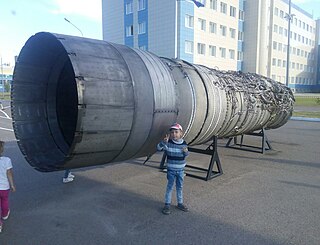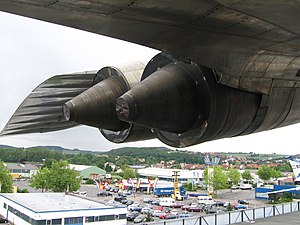
The Tupolev Tu-144 is a Soviet supersonic passenger airliner designed by Tupolev in operation from 1968 to 1999.
The plug nozzle is a type of nozzle which includes a centerbody or plug around which the working fluid flows. Plug nozzles have applications in aircraft, rockets, and numerous other fluid flow devices.

The Tupolev Tu-110 was a jet airliner designed and built in the USSR, which saw its maiden flight in 1957.

The Myasishchev M-4 Molot was a four-engined strategic bomber designed by Vladimir Mikhailovich Myasishchev and manufactured by the Soviet Union in the 1950s to provide a Long Range Aviation bomber capable of attacking targets in North America.

The Myasishchev M-50 is a Soviet prototype four-jet engine supersonic strategic bomber which never attained service. Only one flightworthy prototype was built, which was first flown in October 1959. The M-50 was constructed by the Myasishchev design bureau.

The Soloviev D-30 is a Soviet two-shaft low-bypass turbofan engine, officially referred to as a "bypass turbojet". It is one of the most powerful turbofan engines developed in the Soviet Union. Development of the turbofan spurred numerous growth versions with increased fan diameter and modified component arrangements. Developed in a short period of time, the D-30 turned out to be one of the most reliable engines in the history of Soviet engine development, and it was recognized with the USSR State Prize.
The Kuznetsov Design Bureau was a Russian design bureau for aircraft engines, administrated in Soviet times by Nikolai Dmitriyevich Kuznetsov. It was also known as (G)NPO Trud and Kuybyshev Engine Design Bureau (KKBM).

The Myasishchev M-55 is a high-altitude reconnaissance aircraft developed by OKB Myasishchev in the Soviet Union, similar in mission to the Lockheed ER-2, but with a twin-boom fuselage and tail surface design. It is a twin-engined development of the Myasishchev M-17 Stratosphera with a higher maximum take-off weight.

The Kuznetsov NK-32 is an afterburning three-spool low bypass turbofan jet engine which powers the Tupolev Tu-160 supersonic bomber, and was fitted to the later model Tupolev Tu-144LL supersonic transport. It produces 245 kN (55,000 lbf) of thrust in afterburner.

The General Electric YJ93 turbojet engine was designed as the powerplant for both the North American XB-70 Valkyrie bomber and the North American XF-108 Rapier interceptor. The YJ93 was a single-shaft axial-flow turbojet with a variable-stator compressor and a fully variable convergent/divergent exhaust nozzle. The maximum sea-level thrust was 28,800 lbf (128 kN).

The Rolls-Royce/Snecma Olympus 593 was an Anglo-French turbojet with reheat, which powered the supersonic airliner Concorde. It was initially a joint project between Bristol Siddeley Engines Limited (BSEL) and Snecma, derived from the Bristol Siddeley Olympus 22R engine. Rolls-Royce Limited acquired BSEL in 1966 during development of the engine, making BSEL the Bristol Engine Division of Rolls-Royce.

The Kuznetsov NK-144 is an afterburning turbofan engine made by the Soviet Kuznetsov Design Bureau. Used on the early models of the Tupolev Tu-144 supersonic aircraft, it was very inefficient and was replaced with the Kolesov RD-36-51 turbojet engine.
The Yakovlev Yak-33 was a vertical takeoff and landing supersonic multi-purpose aircraft family, studied in the early 1960s, with variants of a basic design used to fulfill different roles, in a similar fashion to the Yak-25, Yak-27, Yak-28 family.

The Kuznetsov NK-25 is a turbofan aircraft engine made by the Soviet Kuznetsov Design Bureau and used in the Tupolev Tu-22M strategic bomber. One of the most powerful supersonic engines in service today, it is rated at 245 kN (55,000 lbf) thrust. The three shaft engine was designed in the years 1972–1974.

The Progress D-436 is a triple-spool high-bypass turbofan engine developed by the Ukrainian company Ivchenko-Progress, and manufactured by Motor Sich in Ukraine. It was initially developed to meet the requirements for late versions of the Yakovlev Yak-42 and the Antonov An-72 in the 1980s. The engine first ran in 1985 and was subsequently certified in 1987. Several variants have been developed and are currently in service with a variety of aircraft.

The Mikulin AM-3 was a turbojet engine developed in the Soviet Union by Alexander Mikulin.

The Dobrynin RD-7 or "VD-7" is a Soviet single-shaft axial-flow turbojet engine, which was produced in a small series. "RD" means реактивный двигатель. Designed by designer Vladimir Alekseevich Dobrynin, it was intended for installation on the Myasishchev Type 103 strategic bomber.
The Tupolev Voron was a planned supersonic unmanned reconnaissance aircraft of the Soviet Union manufactured by the company Tupolev, largely based on or designed to compete with the Lockheed D-21.
The Rybinsk RD-36-35 was a small lift turbojet engine, designed for use on V/STOL aircraft at the Rybinsk Engine Design Bureau (RKBM), designed by Pyotr A. Kolesov. Very little is known of this engine, probably due to confusion with the similarly designated Kolesov RD-36 and Lotarev D-36, which have little or no relation to the lift-jet.
The Progress AI-22 is a turbofan engine, developed by ZMKB Progress, Motor Sich JSC, KMPO and KAPO.














